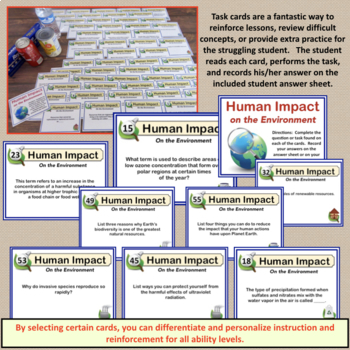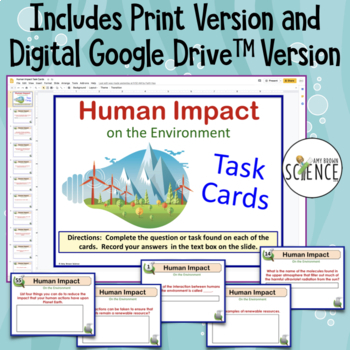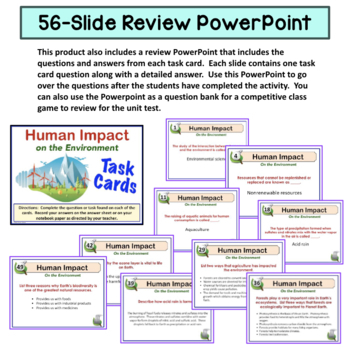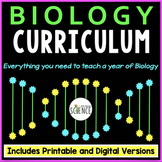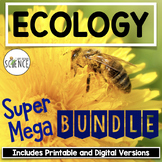Human Impact Task Cards
- Zip
- Google Apps™

What educators are saying
Also included in
- This NO PREP, PRINTABLE, EDITABLE, AND DIGITAL Biology Curriculum contains everything you need for an entire year of Biology! For less than $3 a day, you can save your time, energy, and sanity. Each of the 20 Complete Units includes a teaching PowerPoint presentation, notes, labs, homework assignmenPrice $525.00Original Price $988.18Save $463.18
- This "Humans and the Environment Complete Unit Bundle" includes everything you need to teach a unit on "Human Impact on the Environment" to your life science or biology students. From the engaging PowerPoint to the final unit test, this bundle contains loads of NO PREP materials that are ready to bePrice $29.50Original Price $37.97Save $8.47
- All of my ecology and environmental science resources (6 ecology unit bundles) are included in this one Super-Mega-Bundle! This mega-bundle includes all of the PowerPoints, notes, labs, task cards, homework assignments, review games, quizzes, activities, and unit tests that you need to teach a compPrice $178.00Original Price $252.64Save $74.64
Description
This is a set of 55 enrichment, reinforcement and review task cards for your lessons on "Human Impact on the Environment." Students will identify the many ways that humans have changed the biosphere, and will answer questions about ozone destruction, the greenhouse effect and global warming. Students will use their critical thinking skills to answer questions about the importance of biodiversity and keystone species. Key vocabulary words are thoroughly covered.
Choose to use the traditional printable version, or the paperless, digital Google Apps version. Both Google Slides and Google Forms versions are included. Suitable for life science and biology students in grades 8 - 12.
This resource is perfect for distance learning and for students in 1:1 classrooms.
Click this link to view all of my Digital Resources.
What is included in this resource?
- A set of 55 printable and editable task cards.
- Paperless Digital Versions for use in Google Drive, Google Classroom, and/or Microsoft OneDrive.
- Google Slides version (not editable)
- Google forms version (editable)
- Student answer sheet for recording answers.
- Blank task cards so that you can add additional questions.
- A complete teacher answer key. (7-pages)
- Teacher Guide containing tips, tricks, and suggestions for use. (4-pages)
- Review PowerPoint of 56 slides.
Task cards are a fantastic way to enrich or reinforce lessons, review difficult concepts, or provide extra practice for the struggling student. The student reads each card, performs the task, and records his/her answer on the included student answer sheet.
From the moment of purchase, you will be ready to use your task cards in just a few minutes. Simply print the sheets of task cards on card stock paper, laminate, and cut the cards apart. The cards look best when printed in color, but they can easily be printed in black and white.
This set of 55 task cards on "humans and the biosphere" covers the following concepts and topics:
- Planet Earth and environmental science.
- A brief history of the human impact on planet Earth: Hunters and gatherers, agriculture, industry, and urban development.
- Renewable and Nonrenewable Resources: Definitions and examples.
- Sustainable development.
- Land resources: The importance of land, land as a renewable resource, composition of soil, human impact on soil, erosion, desertification, good land management.
- Forest resources: The importance of forests as a producer of human goods and services, the ecological role of the forests, renewable forests, nonrenewable forests, old growth forests, deforestation, good management of forests.
- Fishery resources: The importance of fisheries to humans and to the environment, overfishing, fisheries as a renewable resource, aquaculture.
- Air resources: Air quality, smog, the pollutants in smog, the burning of fossil fuels, acid rain.
- Freshwater resources: Water use by humans, how pollutants enter the water supply, the role of nature in the cleaning and purifying of water.
- The Human Influence on the Biosphere: Ozone depletion, rising levels of carbon dioxide, population growth.
- Ozone Depletion: Definition of ozone, importance of ozone in our atmosphere, the harmful effects of ultraviolet radiation, how humans are causing the destruction of the ozone, chlorofluorocarbons (CFC's), global regulations of CFC's.
- Increasing Levels of Carbon Dioxide: The role of carbon in the carbon cycle, the addition of too much carbon dioxide to the atmosphere, the danger of rising carbon dioxide levels, global warming, the greenhouse effect.
- Human Population Growth: Estimation of future population size and the effect this will have on our planet.
- Biodiversity: Definition of biodiversity, how biodiversity is measured, the importance of biodiversity, ways biodiversity is lost, extinction, the threat of pollution to biodiversity, keystone species, the use of DDT in the environment, biological magnification, the threat of invasive species.
Related Products Include:
Human Impact on the Environment PowerPoint and Notes Set
Set of 2 Homework Assignments / Study Guides for Human Impact on the Environment
Lab: The Effect of Acid Rain on Seed Germination
Calculating Water Use and Energy Consumption in the Home
Quiz Set of 2: Human Impact on the Environment
Human Impact on the Environment Review PowerPoint Questions and Answers
Human Impact on the Environment Unit Test
FREE Set of Six Ecology Crossword Puzzles
Biomes and Aquatic Ecosystems Task Cards
Introduction to Ecology Task Cards
For updates about sales and new products, please follow my store:
I would love to have you follow me at these locations as well:
My Blog: Amy Brown Science.com
Instagram: @AmyBrownScience


